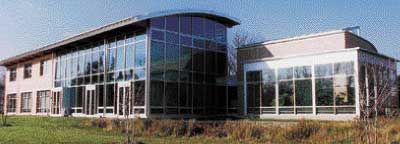

|
|
CAN BUILDINGS BE LIKE TREES?
Perhaps they can. The Lewis Center is designed to run on sunlight.
It doesn't pollute. And its components aren't sent to landfills
when the building dies; they can biodegrade or be recycled. "Every
era has an image," says David Orr, chair of Oberlin's environmental
studies program. "The image of the industrial age is a machine.
That was the metaphor that preceded this building. The idea behind
the Lewis Center is to change the metaphor. This building, like
a tree, will grow and change over time."
The architectural revolution used by Lewis Center architects William McDonough + Partners is patterned after trees. Trees run on solar power, don't produce contaminants, and return to the earth as plant food when they die and decay. On the drafting board, these ideas translate into solar-powered buildings made of non-toxic materials. But McDonough takes the concept a step further: He wants environmentally oriented factories to produce non-toxic products. "If your car is producing greenhouse gases, how can you say that it's a quality product?" he asks. The bad news is the price tag--nobody wants to venture a guess as to how much it would cost to recreate our world along the environmental model. The good news is that we don't have to give up our cars, televisions, and other toxin-laden products. If industrial chemists and technicians redesign our creature comforts to be eco-effective, we can have our cars and drive them, too. The idea behind this philosophy is simple: you don't have to clean up a mess if you don't make it in the first place. The Lewis Center offers a small-scale "how-to" model. The heating and cooling system was designed to be largely a closed "loop" that taps geothermal wells. A passive solar system absorbs the sun's heat during the winter and keeps it out in the summer. "This building is strategic," says McDonough. "It says these are the technologies that are coming." McDonough rejects many of the conventional environmental wisdoms of the late 20th century, such as standard reduction programs that merely downcycle our leftovers. High-quality plastic, for example, is transformed into low-grade plastic products that eventually wind up at the dump. A targeted 10 percent cut of greenhouse gases and toxic waste, while encouraging, still leaves 90 percent cooking the planet. "Being less bad is being less bad," he says. "If you are going 100 miles an hour to Canada, but you're supposed to go to Florida, it's not going to do any good to slow down to 20." The recycle/downcycle distinction is beginning to take root in corporate America. Take Interface, a billion-dollar-a-year manufacturer of carpeting for corporate buildings. The company instituted a top-to-bottom campaign to root environmental damage from its operations. "Downcycling just delays the day the stuff ends up at the dump," says company chair Ray Anderson, who describes the conversion in his book Mid-Course Correction. "But when you close the loop, you keep those molecules going indefinitely." One hallmark of that campaign is the Evergreen Lease, a program in which Interface leases and then maintains the carpeting for its clients, the Lewis Center included. When the carpet wears out, Interface takes it back, not for downcycling into low-end products; but for recycling: the carpet's high-end nylon fibers are recycled into new high-end carpet fibers. Thus, the costly nylon molecules are never lost. This translates into energy savings for the company and, ultimately, money in the bank. Since Interface began its ecological turnabout, it has saved about $143 million. "Without a doubt it's good business," says Anderson, "and that is the hook that will attract mainstream business to environmentalism. You can attract a certain percentage of businesses on the ethics of the matter, but mainstream business is focused on the bottom line to the exclusion of everything else."
|
